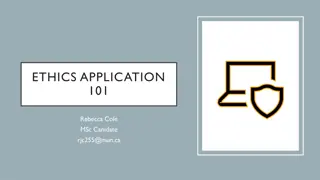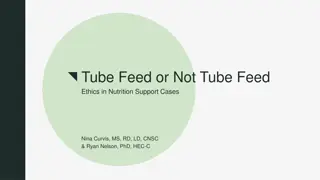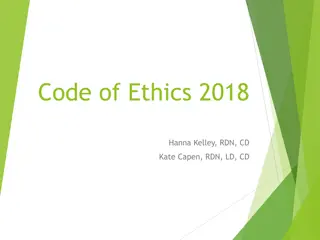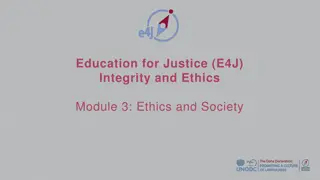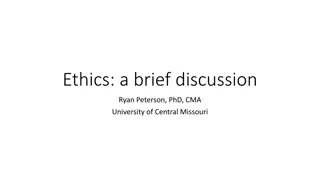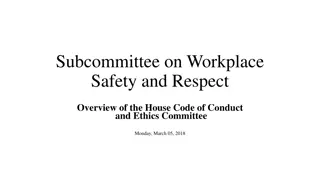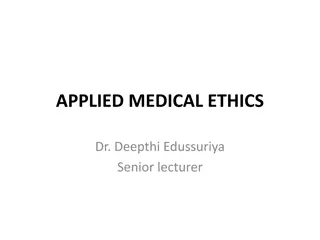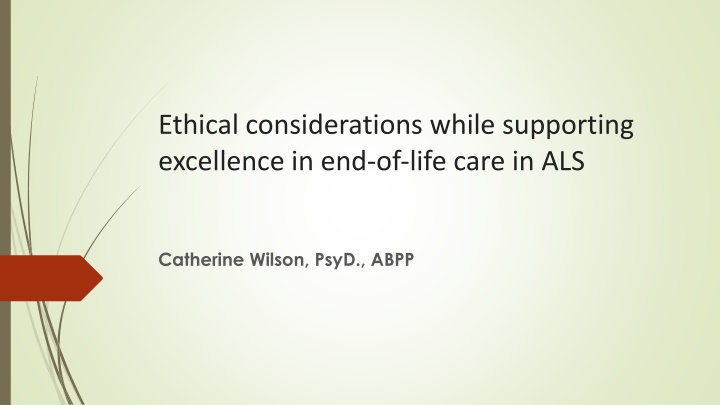
Ethical Considerations in ALS End-of-Life Care
Explore ethical considerations in providing excellent end-of-life care for ALS patients, including identifying symptoms, ethical issues, and initiating end-of-life discussions. Learn about the impact of ALS, its incidence, prevalence, and challenges faced during the COVID-19 pandemic.
Download Presentation

Please find below an Image/Link to download the presentation.
The content on the website is provided AS IS for your information and personal use only. It may not be sold, licensed, or shared on other websites without obtaining consent from the author. If you encounter any issues during the download, it is possible that the publisher has removed the file from their server.
You are allowed to download the files provided on this website for personal or commercial use, subject to the condition that they are used lawfully. All files are the property of their respective owners.
The content on the website is provided AS IS for your information and personal use only. It may not be sold, licensed, or shared on other websites without obtaining consent from the author.
E N D
Presentation Transcript
Ethical considerations while supporting excellence in end of life care in ALS Catherine Wilson, PsyD., ABPP
Sponsorship and Support - Individual grants / projects - This material is the result of work supported with resources and the use of facilities at the James A. Haley Veterans Hospital, and do not represent the views of the Department of Veterans Affairs or the United States Government. Michael Bilirakis VA Spinal Cord Injury Center James A. Haley Veterans Hospital Tampa, FL
Objectives Identify symptoms of ALS Identify ethical issues faced that can arise with end-of- life issues: (Autonomy vs. Paternalism, Confidentiality, Patient-Provider Relationships) Identify ethical end-of-life issues (Advance Directives- Treatment Withdrawal) List the six triggers for initiating discussion about end-of- life with patient and family
Amyotrophic Lateral Sclerosis Military Personal Higher risk of developing the disease than non-military Mean survival rate 3-5 years 50% die within 3 years 20% live 5 years 10% live 10 years Small population-symptoms can halt Prognosis for an ALS pt in 2020 is the same for a person diagnosed in 1869!
Incidence/Prevalence ALS affects approximately 1 of every 100,000 people Based on the U.S population studies a little over 5,600 people are diagnose with ALS a year, that is 15 new cases a day. The life span of ALS patients is 3 to 5 years after they are diagnose ALS is most commonly diagnosed in middle age people and it normally affects men more than it affects women If you served in the military 2x higher possibility.
COVID-19 Effects on ALS Treatment Medical services have been disrupted Multidisciplinary team care, feeding tubes, wheelchairs, home health, and hospice more difficult to obtain and in some places unavailable Spirometry unavailable at most ALS clinical sites in US Non-invasive ventilation(NIV)delayed starting Personal protective equipment unavailable to deal with issues of aerosol dispersion Palliative care visits were restrictive Loss of socialization (Andrews JA, Berry JD, Baloh RH, Carberry N, Cudkowicz ME, Dedi B, Glass J, Maragakis NJ, Miller TM, Paganoni S, Rothstein JD, Shefner JM, Simmons Z, Weiss MD, Bedlack RS. Amyotrophic lateral sclerosis care and research in the United States during the COVID-19 pandemic: Challenges and opportunities. Muscle Nerve. 2020 Aug;62(2):182-186. doi: 10.1002/mus.26989. Epub 2020 Jun 5. PMID: 32445195; PMCID: PMC7283687.)
Team Approach Best delivered by multidisciplinary team (physicians- neurologists & pulmonologists, occupational, physical, and speech therapists, nutritionists, social works, home care and hospice nurses) Medications can be prescribed to treat fatigue, muscle cramp and stiffness, excessive saliva, pain, depression, sleep disturbance. Also important to work with the family
Ethical Issues Faced Treating Veterans with ALS Autonomy vs. Paternalism Models of Patient-Provider Relationships Use of Medical Technology Advance Directives-Treatment Withdrawal Selection of Rehabilitation Candidates Rehabilitative Goals Initiation of Specific Treatments
Howto Recognize Ethical Dilemmas Feelings of discomfort Conflict with values, personally and professionally Dissonance with virtues Dissonance with moral reasoning
Standards for Judging Decisional Capacity Understanding Relevant Information Appreciating the Situation and Its Consequences Manipulating Information Rationally Communicating Choices
Palliative Care WHO Definition The active total care of patients whose disease is not responsive to curative treatment. Control of pain, of other symptoms, and psychological, social and spiritual problems is paramount. The goal of palliative care is the achievement of the best quality of life for patients and their families . palliative care affirms life and regards dying as a normal process THIS IS NOT HOSPICE
When does the end of life begin? At the time of the diagnosis of progressive condition? Sometime later, but when? Curative Palliative Dx Time
The Operational Definition of End-Of-Life in ALS 6 Triggers 1. The patient or family asks or opens the door for end-of-life information and/or interventions (elicited or spontaneous, verbal or non-verbal), or 2. Severe psychological and/or social or spiritual distress or suffering, or 3. Pain requiring opiates, or 4. Dysphagia requiring feeding tube, or 5. Dyspnea or symptoms of hypoventilation, forced vital capacity at 50% or less, or 6. Loss of function in two body regions
Spirituality Present Status Spiritual needs are still largely neglected even in the context of end-of-life care Practice Recommendations Incorporate spiritual care as an integral component of palliative care for the patients and their families by the multidisciplinary ALS team Professional involved in the care of patients with ALS should have spiritual care education
Ethics, Communication, and Decision Making Physicians Lack of familiarity of how to discuss difficult issues: Dx of Cancer, ALS, high level SCI need for assistive devices, end-of-life discussions Too much too late is a consistent issue for Cancer and ALS care Reluctant to treat the end of life patient as they are futile Lack of knowledge on use of pain-control medications and the issue of withdrawing life- sustaining treatment Lack of knowledge about ALS in other specialties: PEG, NIPPV, Trach, Hospice care, etc.
Ethics in ALS for Physicians Avoid being impersonal or dismissive when breaking news of the diagnosis. Do not abandon patients, even if faced with unacceptable behavior or requests. Physicians are not obliged to discuss or aid in the delivery of unproven therapies. Surrogate decision-makers must represent the patient's wishes, not their own. Provide supportive intervention, not confrontation, if faced with ethically questionable actions.
Clinicians Must Review Their Own Experience and Attitude Clinicians first must come to terms with their own deaths Clinicians own attitudes about dying and choices they may or they may not make for themselves
Withhold Medical Treatment Nearly 60-70% of seriously ill patients are unable to speak for themselves when the time comes to decide whether or not to limit treatment Nutrition and hydration treatments Two positions: Nutrition and hydration are palliative treatments that fulfill a basic human need and should not be denied to patients at the end of life. Withholding food and water is similar to the act of killing a patient or allowing a person to die. Mechanical ventilation uses a machine to inflate and empty a patient s lungs allowing oxygenation of the blood.
Common Behavioral Changes in ALS 1. Reduced motivation in 80% of the ALS cases, 2. 41% of them having moderate-severe apathy 3. Depression was present in 30% of ALS patients and did not contribute significantly to the presence of behavioral symptoms. ( my research not yet publish only identified 11%) 4. Bulbar and limb onset ALS patients did not differ. In conclusion, apathy was the most prominent feature inALS patients. Lillo et al 2011
Case Report first Veteran With ALS 52 year old, divorced, female Rapidly progressing ALS with pseudobulbar affect Lived alone in own home, two dogs Employed as administrative specialist for DOD Parents divorced both living Born and raised in a suburb of Chicago GED completed in Military Served in Navy (1993-1997-2000-2003) 2 sisters (Chicago, and Arizona) Good family support One biological son (put up for adaption at 2yo)
Psychological Assessment MMSE score 29/30 PHQ-9 Total Score: 14. (No noted hopelessness or anhedonia , most symptoms endorsed somatic) feeling sad due to adjustment to rapid functional decline refused to accept wheelchair Previous suicide attempt in 1990 (over dose) No noted substance abuse No noted history of anxiety, PTSD, OCD, or manic symptoms
Nursing Challenges SCI patients are treated with an aggressive rehabilitation program Dependence to Independence care model RESTORATIVE PROCESS Veteran was young and female nurse identified with her age and gender Veteran had endearing sense of humor Her progresses was progressive Marked with the goal of complete control
Nursing Concerns Emotionally attached to patient due to her length of stay and caring nature Increased time at bedside with patient as patient progressed with ALS Experienced Frustration and Anger at Patient Experienced Guilt because of those feelings Feeling of futility, observing the patient decline Boundary issues Fear of being the one who kills her Internal conflict: restorative vs. palliative care
Nursing Ethical Concerns Do I follow orders that I feel are unsafe related to patient decisions. I want to help her, do what she wants, but patient refuses to use the technology to assist her to communicate. I feel guilt when I rush care of my other patients because one patient is consuming my day.
Psychological Interventions August-September Assessment Educated to adjustment issues Focused on accepting her need for support at home Not interested in learning about ALS or end of life issues Veteran accepts medication for depression and pseudobulbar affect September-December Unsuccessful discharged home with sister Accept use of wheelchair Accepts finding placement for her dogs Agrees to address end of life issues Finds her son who has four children/creates family conflict Reassess mood: Veteran refuses Tube placement or any other intervention January-February Staff uncomfortable with Veteran on Unit Refuses to consider Nursing home placement Staff at odds with veteran refusing tube placement: palliative care and pain management Confidentiality issues with reconnecting with son Assist nursing with guilt over inability to care for other Veterans
The Case for the Acceptance of Death Ethical Right To Autonomy Death as a Reasonable Alternative to Life Assessment Concerns What beliefs stimulated the want to end of life? Feeling of non-deserving Burden on others Overwhelmed with the future
Personal Struggles Emotional education sessions with patient Feeling unprepared to handle certain situations Difficulty in going against recommendations to keep patient safe (i.e. diet consistency) Difficulty in watching patient suffer
Personal Struggles of Staff Felt too attached to the client Would have crying sessions with Psychologist First slow death experience Unprepared to deal with slow death
Lessons Learned Early education to medication issues, adaptive equipment, assistive technology Staff more open to personal issues Understanding depression, grief, distress Ethic consult sooner Feeding tube placement early with monitoring
Ethical Considerations: Sanctity of Life Doctrine all human life has worth and therefore it is wrong to take steps to end a person's life, directly or indirectly, no matter what the quality of that life. This is in keeping with both traditional codes of medical ethics and a general perception of what doctors and other health professionals should do, that is save and preserve life.
Sanctity of Life Doctrine One challenge to this principle in the context of health care is to ask should life be preserved at all costs. Is there no place for consideration of quality of life? One of the problems with considering quality of life is the question of how this is defined and by whom.
Acts /omissions distinction there is a difference between actively killing someone and refraining from an action that may save or preserve that person's life. a doctor could not give a patient a lethal injection to end his/her life, whatever the circumstances, but could, withhold treatment that may sustain it. if the patient's quality of life was so poor, and the burden of treatment so great, that it would not to be in the patient's best interests to continue treatment.
Doctrine of Double Effect there is a moral distinction between acting with the intention to bring about a person's death and performing an act where death is a foreseen but unintended consequence. there is a moral distinction between acting with the intention to bring about a person's death and performing an act where death is a foreseen but unintended consequence. Prescribing pain relieving drugs which in large doses shorten the life of a terminally ill patient is often used as an example of double effect
Respect for autonomy the right of a patient to have control over his or her own life, including decisions about how his/her life should end competent person should be able to refuse life saving treatment in both current situations and future foreseeable situations Should respect for autonomy mean that a person can request assistance in ending his/her life?
A duty to act in the patient's best interest (Beneficence) To act in a way that benefits the patient, is an important ethical principle in health care. In treatment decisions at the end of life the dilemma often revolves around what course of action will be in the patient s best interests if existing quality of life is so poor, or treatment is very burdensome, then the balance of harms and benefits may suggest that continuing treatment is not a benefit to the patient.
A duty not to harm (Nonmaleficence) an obligation not to inflict harm intentionally, is distinct from that of beneficence - an obligation to help others in the context of health care it can sometimes be difficult to comply with this principle depending on the definition of harm In end of life decisions the question of how much harm is caused by the treatment needs to be considered, as does the question of whether death itself is always a harm.
Stressful 56 year old, Male, never married, one sister who live in Florida Completed GRD and after service in the Army was a mechanic Diagnosed with ALS in 2012 Rapidly progressing ALS with dysphagia, peg tube, chronic respiratory failure Good family support: sister, brother in law and niece and nephew Mechanical ventilation completed in 2015 Veteran lived with sister and moved to VA long term care in 2015 Psychologically met criteria for Adjustment Disorder due to medical condition ( sister believes Veteran always been depressed, lived alone, worked, went home and never socialized) Veteran very anxious at shift change at night. Spent most nights up late. Would not allow cuff to be down especially at night needed to be able to speak to staff. Do to this, lungs were now compromised and he no longer to tolerate cuff down.
Psychological Assessment MMSE score 29/30 PHQ-9 Total Score: 10. (feeling depressed, angry, no energy, unable to sleep) was on non clinical dose of antidepressant and then refused it months before death. No noted substance abuse prior to hospitalization No noted history of anxiety, PTSD, OCD, or manic symptoms but had bouts of anxiety since his ALS( believes he will die at night does not want sister to leave his side; if she is not with him he is on call light multiple times a night) Veteran has bouts of feeling he could not breathe, had infections which did not respond to treatment Veteran has anxiety medication but refuses it and sister also refuses to let staff administer it because Veteran sleeps during the day and is not awake Sister believes night respiratory staff are not doing his care correctly thus constantly requesting to change things. Sister leaves at 1am Veteran dies at 2am.
TEAM CONCERNS Comfort care or aggressive treatment Emotionally sister becomes aggressive with staff about his treatment Increased time at bedside with patient as patient progressed with ALS ( many team members tell sister and Veteran that he is at end stages of his ALS and if not comfort care it will be a painful death) Experienced Frustration and Anger at Patient s sister Experienced Guilt because of those feelings Feeling of futility, observing the patient decline and refusal of comfort care Boundary issues Fear of being the one who kills him Internal conflict: restorative vs. palliative care
The root premise is the concept, fundamental in the American jurisprudence system, that every human being of adult years and sound mind has a right to determine what shall be done with his own body....
The worst death for anyone is to lose the center of his being, the thing he really is. Hemingway, 1966
Life is not the absolute or ultimate goal nor death the absolute evil. Cassem 1980
The Case for the Acceptance of Death Ethical Right To Autonomy Death as a Reasonable Alternative to Life
Ethical Cases: QUSESTONS: I thought if I had a Trach tube placement it will fix my ALS, it hasn t What Role does the team play as part of the interdisciplinary team in discussing end of life issues with ALS Patients What responsibility do team members have in answering end of life questions the family might ask
Goals of Care Conversation Talking Map 1. Introduction of the conversation 2. Identify Authorized Surrogates 3. Assess Understanding of Health 4. Elicit Veteran s Values and Goals of Care 5. Support Veteran s Goals 6. Discussion Summary and Next Steps (follow up plan)
Why was change needed? 48 Conversations about goals and LST decisions often initiated too late after a medical crisis or loss of decision-making capacity Difficult to locate CPRS documentation of the patient s goals of care and LST decisions Currently, VA orders pertaining to LST are limited to CPR no orders to reflect decisions about feeding tubes, mechanical ventilation, dialysis, others The LST Decisions Initiative is a national quality improvement effort to address these concerns.
VHA Handbook 1004.03 (LST Handbook) Standardizes processes related to: Conducting goals of care conversations with high risk patients Documenting goals of care and LST decisions in CPRS Honoring LST decisions Also addresses: Establishing LST plans for patients who lack decision-making capacity and do not have a surrogate Resolving conflicts regarding LST treatment Conscientious objection VA prohibition against assisted suicide and euthanasia Facilities had until July 11, 2018 (18 months from the date of publication) to establish facility policy and implement new practices 49
Proactive Goals of Care Conversations 50 Patients high risk At risk for a life-threatening clinical event within the next 1-2 years Prior to medical crisis, in the outpatient setting whenever possible Can be identified through clinical judgment ( surprise question) and objective screening tools (e.g., CAN* scores in Primary Care) Or patients who express the desire to limit life-sustaining treatment Clinicians who care for high-risk patients Multiple disciplines: discuss values, goals, preferences with patients and surrogates Physicians, residents, APRNs, and PAs: confirm LST plan and write LST progress notes/orders * CAN = Care Assessment Need: indicates risk of hospitalization or death




